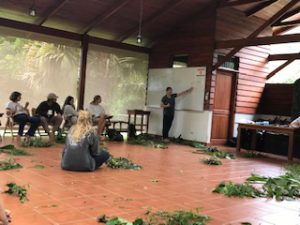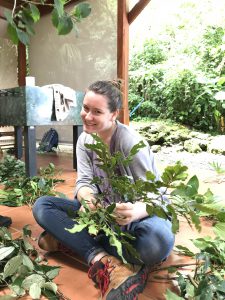By Addison Dennard
Milton and Diana Lieberman are retired professors from the University of Georgia. They moved to Costa Rica, where they conducted and continue to conduct research and teach tropical ecology. Diana has a degree in biology from the University of California and a Ph.D. in botany from the University of Ghana. Luckily for us, their coffee farm is right down the road from campus, so they were able to spend an afternoon teaching us plant taxonomy. However, this was not a typical lecture. Instead of bringing books a nd assignments, Dr. Lieberman brought live plants. The class was split into four separate groups, and each group was given an assortment of various plants to identify. She wanted us to use our “five-year-old” brains. Specifically, we were going to learn from making simple structural observations of these plants and eventually deducing families and species. Fi
nd assignments, Dr. Lieberman brought live plants. The class was split into four separate groups, and each group was given an assortment of various plants to identify. She wanted us to use our “five-year-old” brains. Specifically, we were going to learn from making simple structural observations of these plants and eventually deducing families and species. Fi rst, we were instructed to sort the plants into separate species, based on similarities in structure. Although we did not learn the names of these plants, the act of examining and comparing them helped familiarize their structures. Next, we split the small groups of species into two large groups: monocots and dicots. Dicots have branched veins in their leaves, while monocots have parallel veins going in the same direction. Afterwards, we subdivided the plants into alternate and opposite branching patterns. This was based on whether the leaf buds were positioned directly adjacent to each other (opposite) or alternating along the stem. Finally, we further classified the branching pattern as simple or complex. Simple plants have only one leaflet per bud, while complex have branching leaves per bud. We were finally ready to learn the names of the plants. “Bring up the monocot, with a simple opposite branching pattern,” Dr. Lieberman would say, “does anybody know what this family is used for?”. “Agriculture…food…biofuel…,” we would all reply. In addition to the names
rst, we were instructed to sort the plants into separate species, based on similarities in structure. Although we did not learn the names of these plants, the act of examining and comparing them helped familiarize their structures. Next, we split the small groups of species into two large groups: monocots and dicots. Dicots have branched veins in their leaves, while monocots have parallel veins going in the same direction. Afterwards, we subdivided the plants into alternate and opposite branching patterns. This was based on whether the leaf buds were positioned directly adjacent to each other (opposite) or alternating along the stem. Finally, we further classified the branching pattern as simple or complex. Simple plants have only one leaflet per bud, while complex have branching leaves per bud. We were finally ready to learn the names of the plants. “Bring up the monocot, with a simple opposite branching pattern,” Dr. Lieberman would say, “does anybody know what this family is used for?”. “Agriculture…food…biofuel…,” we would all reply. In addition to the names of these plants, Dr. Lieberman taught us their importance and usage. To our surprise, we could effortlessly sort our plants into families solely using the simple structural observations we had made throughout the whole lesson. By the end of the lecture, not only had we learned the family names for these tropical plants, we also familiarized ourselves with plant structures to help us identify plants back home. “Imagine if I dropped you in a remote untouched area,” Dr. Lieberman explained, “there would be no internet, no naturalists, no books. The only way to identify the plants would be through the same simple observations that you have made today.” Thanks to the Lieberman’s, we can now do this, and we gained intuitive knowledge for plant taxonomy.
of these plants, Dr. Lieberman taught us their importance and usage. To our surprise, we could effortlessly sort our plants into families solely using the simple structural observations we had made throughout the whole lesson. By the end of the lecture, not only had we learned the family names for these tropical plants, we also familiarized ourselves with plant structures to help us identify plants back home. “Imagine if I dropped you in a remote untouched area,” Dr. Lieberman explained, “there would be no internet, no naturalists, no books. The only way to identify the plants would be through the same simple observations that you have made today.” Thanks to the Lieberman’s, we can now do this, and we gained intuitive knowledge for plant taxonomy.

